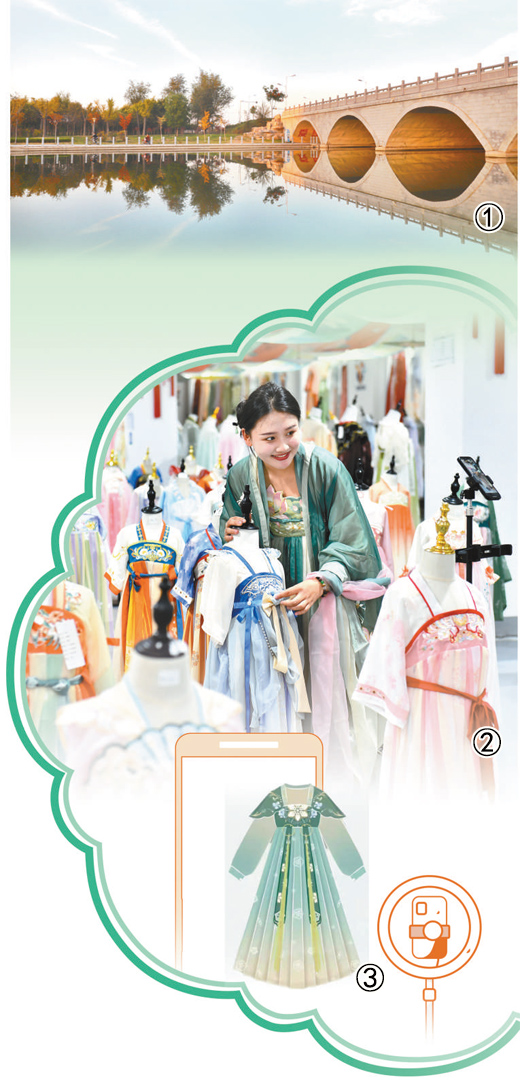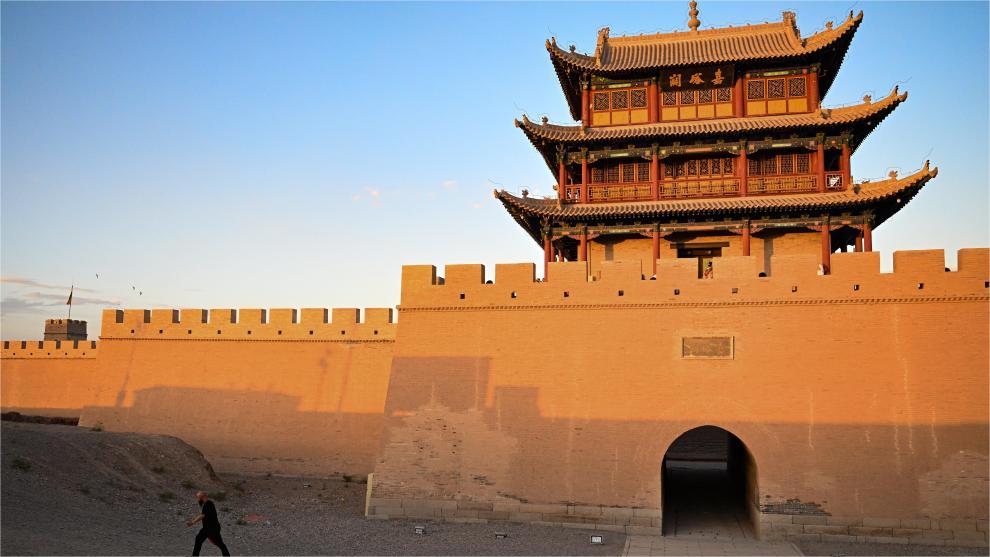Caoxian county in E China's Shandong spearheads Hanfu industry development
Embracing the rising popularity of Hanfu, a style of clothing traditionally worn by the Han people, alongside the growth of e-commerce, Caoxian county in east China's Shandong Province has developed a comprehensive Hanfu industrial chain. This chain encompasses original research and development (R&D), design, production, and online marketing, creating opportunities for young people to return and start businesses.
Caoxian has established itself as one of China's largest industrial clusters for performance costumes and Hanfu. The county boasts over 4,000 upstream and downstream enterprises and over 52,000 online stores in the Hanfu and performance costume industries. Notably, over 70 percent of the county's Hanfu garments feature original designs, and these sectors employ more than 100,000 people.
Sales of Hanfu and performance costumes from Caoxian have exceeded 20 billion yuan ($2.82 billion). Remarkably, the county accounts for over 80 percent of performance costume sales nationwide, as well as 40 percent of Hanfu sales.

1: View of Baliwan Scenic Area in Caoxian county, east China's Shandong Province. (Photo/Hao Zhaohong)
2: A livestreamer advertises Hanfu in Caoxian county, east China's Shandong Province. (Xinhua/Guo Xulei)
3: Photo shows a design drawing of Hanfu. (Photo courtesy of Xietanyizhuang clothing company in Caoxian)
Many locals, including Daji township in the county, were engaged in producing costumes for photo studios in the 1980s and 1990s, with some later selling their costumes online. As e-commerce has boomed since 2013, Caoxian has encouraged young people to return to join the e-commerce industry and has offered training sessions on e-commerce skills.
Responding to the county's call, Yang Wei, a native of Daji township, established a workshop to produce performance costumes and opened an online store. In 2015, Yang moved his workshop to an e-commerce industrial park covering 500 mu (33.33 hectares) in the township.
Driven by the rise of "China-chic," a trend celebrating China's traditional fashion styles, Hanfu's popularity has surged since 2018.
As a result, Yang transitioned into the Hanfu industry. "Most performance costumes are disposable with low profits and strong seasonality. But Hanfu is more profitable and popular year-round," Yang explained.
He provided intensive training to nearby villagers, enhanced their skills, and established a Hanfu livestreaming center, where locals donning Hanfu outfits became livestreamers.
"Thanks to livestreaming e-commerce platforms, online sales now represent 80 percent of my company's total revenue. We host four livestreaming sessions daily, with sales nearing 100,000 yuan. During peak seasons, our daily sales volume can reach between 400,000 yuan and 500,000 yuan," Yang said.
Currently, Caoxian is transforming Daji township and six nearby townships and neighborhoods into e-commerce consortiums, aiming to establish the largest Hanfu intelligent manufacturing and sales hub in China, according to Liu Xia, deputy director of the county's e-commerce service center.
"Hanfu is a part of China's excellent traditional culture. I hope to attract more people to appreciate the beauty of Hanfu by shooting and producing short videos, showcasing unique Chinese elegance to the world," Yang said.
Hu Chunqing returned to Caoxian to start a business in the Hanfu industry after obtaining his Ph.D. degree. He now operates an online Hanfu store focusing on high-end garments.
His wife, Meng Xiaoxia, who majored in fine arts, independently designs Hanfu outfits. With support from the local government, the couple established an original Hanfu R&D center and built an exhibition hall. This hall integrates R&D, design, production, and sales of Hanfu outfits.
"Chinese excellent traditional culture is profound. I keep learning and try my best to integrate classical elements and modern designs into Hanfu," Meng said.
In addition to Hanfu, Caoxian is renowned for shadow puppetry, recognized as a provincial-level intangible cultural heritage, and for wood carving and wicker weaving, both of which are state-level intangible cultural heritages.
After studying with several inheritors of these intangible cultural heritages, Meng Xiaoxia has skillfully integrated these arts into Hanfu designs. Ren Yinlai, a shadow puppetry inheritor, created unique shadow puppet patterns for Meng. She then artfully incorporated these patterns into the horse-face skirt, a traditional Chinese skirt dating back to the Song Dynasty (960-1279) and a distinctive element of Hanfu.
"Shadow puppetry alone struggles to attract large audiences. The younger generation is boldly innovating by combining Hanfu and shadow puppetry. This fusion is beneficial for creating a cultural brand and helps more people learn about Caoxian's shadow puppetry culture," Ren said.
Additionally, the county's wood carving and wicker weaving techniques are used to make Hanfu's accessories.
"The story of Hu and his wife exemplifies Caoxian's e-commerce development. An increasing number of highly educated talents are returning to our county. We are fully confident in the development of the Hanfu industry," said Zhang Longfei, director of the county's e-commerce service center.
"Nurturing a characteristic industry is challenging, so it's crucial to maintain its strong vitality," said Zhao Fulong, Party chief of Caoxian.
Zhao noted that the county is advancing a Hanfu project covering an area of 1,010 mu. This initiative aims to promote integrated development in R&D, design, production, trade, and logistics, extend the Hanfu industrial chain, and strengthen the Hanfu industry.
Hanfu has become a distinctive "calling card" for Caoxian. In 2022, the county established a Hanfu association that has attracted over 200 members. Notably, young people around the age of 25 make up 70 percent of its membership. Since the association's formation, a variety of Hanfu-related activities have been organized, contributing to the growing popularity and active promotion of Hanfu culture among young people.
Photos
Related Stories
- Traditional Han-style wedding held in Hebei
- Han-style group wedding held in Henan
- Han-style clothes displayed at a fashion show in Suzhou
- Newlyweds hold traditional wedding ceremony as 'Qixi' approaches
- Large group wedding in Han style to take place in Chongqing (2)
- College students in Han costumes celebrate Shangsi Festival
Copyright © 2023 People's Daily Online. All Rights Reserved.









